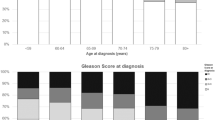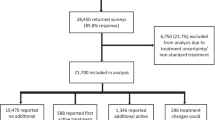Abstract
Prostate cancer is a highly prevalent malignancy in older men. Because the disease and its treatments have the potential to cause substantial morbidity in affected individuals, prostate cancer has been the subject of great interest for quality-of-life (QOL) researchers. In this article, we review published QOL studies that have focused on individuals with prostate cancer. Generic survey instruments have generally been found to be insensitive to changes in health-related quality of life (HR-QOL) related to prostate cancer and its treatments. Domain-specific survey instruments (such as those focusing on sexual function) have been more sensitive, but fail to capture all relevant impacts. At least 9 disease-specific instruments have been developed to measure the HR-QOL impact of prostate cancer. These instruments generally focus on specific symptoms related to the disease and its treatment — urinary function, bowel function, sexual function, physical function, psychological function and pain — however, the domains covered are not consistent from instrument to instrument, and the domains of emphasis within each instrument are rarely the same. In addition, no single instrument has been applied to all major therapies for prostate cancer across men at different ages and stages of disease. Finally, HR-QOL evaluations in some patient groups, such as thosewith advanced disease, have received relatively little attention to date. As a result of the proliferation of prostate cancer-specific survey instruments and inconsistencies in their design and application, decision-makers face great difficulties evaluating HR-QOL across disease stages and comparing the HR-QOL impacts of alternative therapies, including conservative management (‘watchful waiting“). In order for these tools to be useful for patient management and policy-making, coordination of instrument development efforts with the goal of consolidating the number of measures used is urgently needed.
Similar content being viewed by others
References
American Cancer Society. Cancer facts and figures: 1997. Atlanta (GA): American Cancer Society, 1997
Landis S, Marray T, Bolden S, et al. Cancer statistics, 1998. CA Cancer J Clin 1998; 48: 6–29
Yarbro CH, Ferrans CE. Quality of life of patients with prostate cancer treated with surgery or radiation therapy. Oncol Nurs Forum 1998; 25 (4): 685–93
US Congress, Office of Technology Assessment. Costs and effectiveness of prostate cancer screening in elderly men. Washington, DC: US Government Printing Office, 1995. Report no.: OTA-BP-H-145
Herr HW. Quality of life in prostate cancer patients. CA Cancer J Clin 1997; 47 (4): 207–17
Mossey J, Shapiro E. Self-rated health: a predictor of mortality among the elderly. Am J Public Health 1982; 72 (6): 800–9
Idler EL, Kasl S. Health perceptions and survival: do global evaluations of health status really predict mortality? J Gerontol 1991; 46 (2): 555–65
Najman JM, Levine S. Evaluating the impact of medical care and technologies on quality of life: a review and critique. Soc Sci Med 1981; 15F: 107–15
Braslis KG, Santa CC, Brickman AL, et al. Quality of life 12 months after radical prostatectomy. Br J Urol 1995; 75 (1): 48–53
Spilker B, editor. Quality of life and pharmacoeconomics in clinical trials. 2nd ed. Philadelphia (PA): Lippincott-Raven, 1996
Patrick DL, Erickson P. Health status and health policy: allocating resources to health care. Oxford: Oxford University Press, 1993
Tarlov AR, Ware JE, Greenfield S, et al. Medical outcomes study: an application of the methods for evaluating the results of medical care. JAMA 1989; 262 (7): 925–31
Ware JE, Sherbourne C, Davies A. Measuring functioning and well-being: the medical outcomes study approach. Developing and testing the MOS 20-item short-form health survey: a general population application. Durham (NC): Duke University Press, 1992
Stewart AL, Hays RD, Ware JE. The MOS short-form general health survey: reliability and validity in a patient population. Med Care 1988; 26 (7): 724–35
McHorney CA, Ware JE, Rogers W, et al. The validity and relative precision of MOS short-and long-form health status and Dartmouth COOP charts in discriminating among adults with medical and psychiatric conditions: results from the Medical Outcomes Study. Med Care 1992; 30 (5 Suppl.): MS253–65
Litwin MS, Hays RD, Fink A, et al. Quality-of-life outcomes in men treated for localized prostate cancer. JAMA 1995; 273 (2): 129–35
Albertsen PC, Aaronson NK, Muller MJ, et al. Health-related quality of life among patients with metastatic prostate cancer. Urology 1997; 49 (2): 207–16
Schlenk EA, Erlen JA, Dunbar JJ, et al. Health-related quality of life in chronic disorders: a comparison across studies using the MOS SF-36. Qual Life Res 1998; 7 (1): 57–65
Fowler FJJ, Barry MJ, Lu YG, et al. Effect of radical prostatectomy for prostate cancer on patient quality of life: results from a Medicare survey. Urology 1995; 45 (6): 1007–13
Hunt SM, Mekenna SP, McEwen JA. A quantitative approach to perceived health status: a validation study. J Epidemiol Community Health 1980; 34: 281–5
Thorpe AC, Cleary R, Coles J, Northern Regional Prostate Audit Group, et al. Nottingham health profile measurement in the assessment of clinical outcome after prostatectomy. Br J Urol 1995; 76 (4): 446–50
Chapman GB, Elstein AS, Kuzel TM, et al. Prostate cancer patients’ utilities for health states: how it looks depends on where you stand. Med Decis Making 1998; 18 (3): 278–86
Bennett CL, Chapman G, Elstein AS, et al. A comparison of perspectives on prostate cancer: analysis of utility assessments of patients and physicians. Eur Urol 1997; 32 Suppl. 3: 86–8
Simpson KN, Revicki D, Mohler JL. Quality of life with clinically-localized prostatic carcinoma: prostatectomy versus ’watchful waiting’ [abstract no. 19]. Annual Meeting of the International Society for Technology Assessment in Health Care; 1995; Chapel Hill
Albertsen PC, Nease RFJ, Potosky AL. Assessment of patient preferences among men with prostate cancer. J Urol 1998; 159 (1): 158–63
Fowler FJJ, Barry MJ, Luy G, et al. Outcomes of external-beam radiation therapy for prostate cancer: a study of medicare beneficiaries in three surveillance, epidemiology, and end results areas. J Clin Oncol 1996; 14 (8): 2258–65
Cassileth BR, Soloway MS, Vogelzang NJ, Zoladex Prostate Cancer Study Group, et al. Quality of life and psychosocial status in stage D prostate cancer. Qual Life Res 1992; 1 (5): 323–9
Lim AJ, Brandon AH, Fiedler J, et al. Quality of life: radical prostatectomy versus radiation therapy for prostate cancer. J Urol 1995; 154 (4): 1420–5
Beard CJ, Propert KJ, Rieker PP, et al. Complications after treatment with external-beam irradiation in early-stage prostate cancer patients: a prospective multi-institutional outcomes study. J Clin Oncol 1997; 15 (1): 223–9
Perez CA, Michalski J, Ballard S, et al. Cost benefit of emerging technology in localized carcinoma of the prostate. Int J Radiat Oncol Biol Phys 1997; 39 (4): 875–83
Sall M, Madsen FA, Rhodes PR, et al. Pelvic pain following radical retropubic prostatectomy: a prospective study. Urology 1997; 49 (4): 575–9
Curran D, Fossa S, Aaronson N, European Organization for Research and Treatment of Cancer (EORTC) Genito-Urinary Tract Cancer Cooperative Group (GUT-CCG), et al. Baseline quality of life of patients with advanced prostate cancer. Eur J Cancer 1997; 33 (11): 1809–14
Moore MJ, Osoba D, Murphy K, et al. Use of palliative end points to evaluate the effects of mitoxantrone and low-dose prednisone in patients with hormonally resistant prostate cancer. J Clin Oncol 1994; 12 (4): 689–94
Tannock IF, Osoba D, Stockler MR, et al. Chemotherapy with mitoxantrone plus prednisone or prednisone alone for symptomatic hormone-resistant prostate cancer: a Canadian randomized trial with palliative end points. J Clin Oncol 1996; 14 (6): 1756–64
Herr HW, Kornblith AB, Ofman U. A comparison of the quality of life of patients with metastatic prostate cancer who received or did not receive hormonal therapy. Cancer 1993; 71 (3 Suppl.): 1143–50
Borghede G, Sullivan M. Measurement of quality of life in localized prostatic cancer patients treated with radiotherapy: development of a prostate cancer-specific module supplementing the EORTC QLQ-C30. Qual Life Res 1996; 5 (2): 212–22
Borghede G, Karlsson J, Sullivan M. Quality of life in patients with prostatic cancer: results from a Swedish population study. J Urol 1997; 158 (4): 1477–85
Shrader-Bogen CL, Kjellberg JL, McPherson CP, et al. Quality of life and treatment outcomes: prostate carcinoma patients’ perspectives after prostatectomy or radiation therapy. Cancer 1997; 79 (10): 1977–86
de-Haes JC, van Knippenberg FCE, Neijt JP. Measuring psychological and physical distress in cancer patients: structure and application of the Rotterdam symptom checklist. Br J Cancer 1990; 62: 1034–8
Popov I, Jelic S, Radosavljevic D, et al. Androgen level variations, clinical response to LHRH agonists and changes in the quality of life subscales in metastatic prostate cancer: speculations about possible role of the monoamine system. Neoplasma 1997; 44 (5): 308–13
Esper P, Mo F, Chodak G, et al. Measuring quality of life in men with prostate cancer using the functional assessment of cancer therapy-prostate instrument. Urology 1997; 50 (6): 920–8
Lubeck DP, Litwin MS, Henning JM, et al. Measurement of health-related quality of life in men with prostate cancer: the CaPSURE database. Qual Life Res 1997; 6 (5): 385–92
Litwin MS, Nied RJ, Dhanani N. Health-related quality of life in men with erectile dysfunction. J Gen Intern Med 1998; 13 (3): 159–66
Stockler MR, Osoba D, Goodwin P, European Organization for Research and Treatment of Cancer, et al. Responsiveness to change in health-related quality of life in a randomized clinical trial: a comparison of the prostate cancer specific quality of life instrument (PROSQOLI) with analogous scales from the EORTC QLQ-C30 and a trial specific module. J Clin Epidemiol 1998; 51 (2): 137–45
Fossa SD. Quality of life after palliative radiotherapy in patients with hormone-resistant prostate cancer: single institution experience. Br J Urol 1994; 74 (3): 345–51
Helgason AR, Adolfsson J, Steineck G. Disease specific quality of life in men with prostate cancer: a three level epidemiological approach. J Epidemiol Biostat 1997; 2 (4): 213–8
Helgason AR, Adolfsson J, Dickman P, et al. Waning sexual function: the most important disease-specific distress for patients with prostate cancer. Br J Cancer 1996; 73: 1417–21
Helgason AR, Adolfsson J, Dickman P, et al. Factors associated with waning sexual function among elderly men and prostate cancer patients. J Urol 1997; 158: 155–9
Helgason AR, Adolfsson J, Dickman P, et al. Distress due to unwanted side-effects of prostate cancer treatment is related to impaired well-being (quality of life). Prostate Cancer Prostatic Dis 1998; 1: 128–33
Helgason AR, Arver S, Adolfsson J, et al. ’Potency’: the validation of information from a self-administered questionnaire using objective measurements of night-time erections and test-retest reliability. Br J Urol 1998; 81 (1): 135–41
Cleary PD, Morrissey G, Oster G. Health-related quality of life in patients with advanced prostate cancer: a multinational perspective. Qual Life Res 1995; 4 (3): 207–20
Chodak G, Sharifi R, Kasimis B, et al. Single-agent therapy with bicalutamide: a comparison with medical or surgical castration in the treatment of advanced prostate carcinoma. Urology 1995; 46 (6): 849–55
Patient-reported complications and follow-up treatment after radical prostatectomy. The National Medicare Experience: 1988–1990 (updated June 1993). Urology 1993; 42 (6): 622–9
JonlerM, RitterMA, Brinkmann R, et al. Sequelae of definitive radiation therapy for prostate cancer localized to the pelvis. Urology 1994; 44 (6): 876–82
Widmark A, Fransson P, Tavelin B. Self-assessment questionnaire for evaluating urinary and intestinal late side effects after pelvic radiotherapy in patients with prostate cancer compared with an age-matched control population. Cancer 1994; 74: 2520–32
Rossetti SR, Terrone C. Quality of life in prostate cancer patients. Eur Urol 1996; 30 Suppl. 1: 44–8
Jonler M, Madsen FA, Rhodes PR, et al. A prospective study of quantification of urinary incontinence and quality of life in patients undergoing radical retropubic prostatectomy. Urology 1996; 48 (3): 433–40
Author information
Authors and Affiliations
Corresponding author
Rights and permissions
About this article
Cite this article
Sommers, S.D., Ramsey, S.D. A Review of Quality-of-Life Evaluations in Prostate Cancer. Pharmacoeconomics 16, 127–140 (1999). https://doi.org/10.2165/00019053-199916020-00002
Published:
Issue Date:
DOI: https://doi.org/10.2165/00019053-199916020-00002




